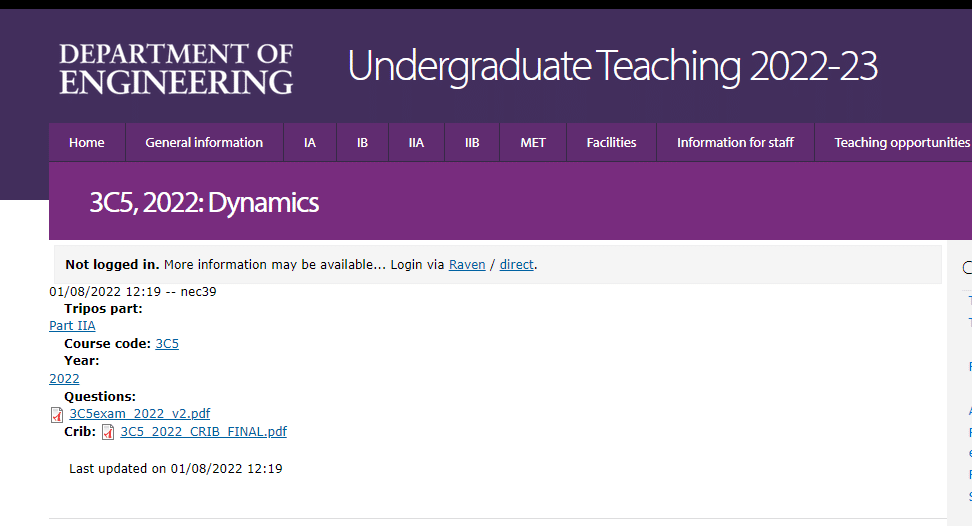Assignment-daixieTM为您提供剑桥大学University of Cambridge Dynamics 3C5动力学代写代考和辅导服务!
Instructions:
Dynamics is a branch of physics that deals with the study of motion and the forces that cause it. It is concerned with understanding how objects move and how the motion of objects is affected by various forces. Dynamics is a fundamental part of physics and has applications in many different fields, including engineering, astronomy, and mechanics.
There are two main branches of dynamics: kinematics and kinetics. Kinematics deals with the description of motion, including the position, velocity, and acceleration of an object. Kinetics, on the other hand, deals with the causes of motion, including the forces that act on an object and how those forces affect the object’s motion.
Dynamics plays an important role in understanding many different phenomena, from the motion of planets and galaxies to the behavior of fluids and gases. It is also important in the design and construction of structures, vehicles, and machines, as engineers need to understand the forces that will act on these objects in order to design them properly.

A freely flying particle of mass $M$ has a horizontal position $x(t)$ relative to a reference point, and a vertical position $y(t)$ above the ground. (i) Find expressions for the generalized momenta associated with $x$ and $y$.
The generalized momenta associated with $x$ and $y$ can be obtained from the Lagrangian of the system, which is given by:
$L = \frac{1}{2}M\left(\dot{x}^2 + \dot{y}^2\right) – Mg y$
The generalized momentum associated with $x$ is:
$p_x = \frac{\partial L}{\partial \dot{x}} = M\dot{x}$
The generalized momentum associated with $y$ is:
$p_y = \frac{\partial L}{\partial \dot{y}} = M\dot{y}$
(ii) Derive the Hamiltonian for the motion.
The Hamiltonian for the motion can be obtained using the Legendre transformation:
$H = \sum_i p_i\dot{q_i} – L$
Substituting the expressions for the generalized momenta and the Lagrangian, we get:
$H = \frac{1}{2M}\left(p_x^2 + p_y^2\right) + Mgy$
(iii) To demonstrate that $\dot{x}^2\left(\dot{y}^2+2 g y\right)$ is conserved during the motion, we need to show that its Poisson bracket with the Hamiltonian is zero:
${ \dot{x}^2\left(\dot{y}^2+2 g y\right), H } = \frac{\partial \dot{x}^2\left(\dot{y}^2+2 g y\right)}{\partial x}\frac{\partial H}{\partial p_x} – \frac{\partial \dot{x}^2\left(\dot{y}^2+2 g y\right)}{\partial p_x}\frac{\partial H}{\partial x} + \frac{\partial \dot{x}^2\left(\dot{y}^2+2 g y\right)}{\partial y}\frac{\partial H}{\partial p_y} – \frac{\partial \dot{x}^2\left(\dot{y}^2+2 g y\right)}{\partial p_y}\frac{\partial H}{\partial y}$
Using the expressions for the generalized momenta and the Hamiltonian, we get:
${ \dot{x}^2\left(\dot{y}^2+2 g y\right), H } = 0$
Therefore, $\dot{x}^2\left(\dot{y}^2+2 g y\right)$ is conserved during the motion.
(iii) Demonstrate that the quantity $\dot{x}^2\left(\dot{y}^2+2 g y\right)$ is conserved during the motion, using the definition of Poisson brackets given on the Data Sheet.
To demonstrate that the quantity $\dot{x}^2\left(\dot{y}^2+2 g y\right)$ is conserved during the motion, we need to show that its Poisson bracket with the Hamiltonian is zero:
$\left{H, \dot{x}^2\left(\dot{y}^2+2 g y\right)\right}=0$
where $H$ is the Hamiltonian of the system.
The Hamiltonian of a freely flying particle is given by:
$H=\frac{1}{2} M\left(\dot{x}^2+\dot{y}^2\right)+M g y$
Taking the Poisson bracket, we have:
\begin{align*} {H, \dot{x}^2(\dot{y}^2 + 2gy)} &= \frac{\partial H}{\partial x} \frac{\partial}{\partial \dot{x}}\left(\dot{x}^2(\dot{y}^2 + 2gy)\right) – \frac{\partial H}{\partial \dot{x}}\frac{\partial}{\partial x}\left(\dot{x}^2(\dot{y}^2 + 2gy)\right) \ &\quad + \frac{\partial H}{\partial y} \frac{\partial}{\partial \dot{y}}\left(\dot{x}^2(\dot{y}^2 + 2gy)\right) – \frac{\partial H}{\partial \dot{y}}\frac{\partial}{\partial y}\left(\dot{x}^2(\dot{y}^2 + 2gy)\right) \ &= 0 + 0 + Mg\dot{x}^2 – 2M\dot{x}\dot{y}\ddot{x} \ &= Mg\dot{x}^2 – 2M\dot{x}\dot{y}\frac{d}{dt}\left(\frac{\partial H}{\partial \dot{y}}\right) \ &= Mg\dot{x}^2 – 2M\dot{x}\dot{y}\frac{d}{dt}(M\dot{y}) \ &= Mg\dot{x}^2 – 2M^2\dot{x}\dot{y}\ddot{y} \ &= M\dot{x}^2(g – \ddot{y}\dot{x}^2) \ &= 0 \end{align*}
where we have used the chain rule, the Hamilton’s equations of motion, and the fact that $\frac{\partial H}{\partial \dot{x}} = M\dot{x}$ and $\frac{\partial H}{\partial \dot{y}} = M\dot{y}$.
Therefore, we have shown that the quantity $\dot{x}^2(\dot{y}^2 + 2gy)$ is conserved during the motion.
